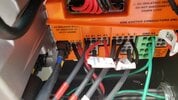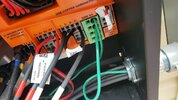7.6 Tesla inverter and 24 panels
All my panels - 24 are pointed south, but i have trees and shading on each side of the roof.
So i asked tesla to install at least 3 strings.
But they told me , since their pipe coming down is not thick enough- only for 4 cables, they have 3 strings, but 2 of which are combined on the roof , so net net , only 2 are coming down
Is this acceptable ?
How come other people can have more cables come down
What is the point of having inverter with 4 MPPTs but tesla cannot use them, as pipe are not thick enough.
All my panels - 24 are pointed south, but i have trees and shading on each side of the roof.
So i asked tesla to install at least 3 strings.
But they told me , since their pipe coming down is not thick enough- only for 4 cables, they have 3 strings, but 2 of which are combined on the roof , so net net , only 2 are coming down
Is this acceptable ?
How come other people can have more cables come down
What is the point of having inverter with 4 MPPTs but tesla cannot use them, as pipe are not thick enough.





